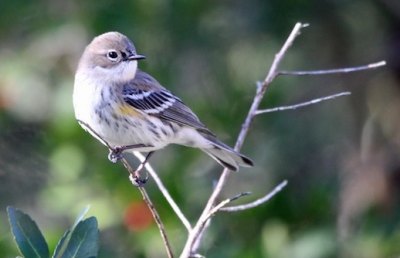The Myrtle Warblers

Spending even the least bit of time in Ocracoke village this winter, you would have no doubt noticed the many small streaky and brown/grayish birds flitting around, dashing from bushes to bushes, even perching on the utility wires. A casual observer may think, gee, there are a lot of sparrows on this island. That observation might perhaps to some degree be accurate (though I don’t think so), but these birds are not sparrows. They are in fact warblers. The easy way to identify this species is to see a yellow patch at the base of their tail feathers. Indeed this marking is where it gets its name, the Yellow-rumped Warbler. The Eastern race of this bird is called the Myrtle Warbler which I prefer to use and even gave my house that name.
Even without binoculars you may also note they have white wing bars and yellow streaks on the sides of the breast. They arrive from their northern nesting grounds beginning around mid-October. More than 30 warbler species have been observed on the Outer Banks, most seen primarily in the spring and fall as they pass through to their respective nesting and wintering grounds. By December, except for this species, very few warblers may still be around, mostly Common Yellowthroats, and a few Palm and Orange-crowned Warblers.
So why are there so many Myrtle Warblers on Ocracoke from fall into early spring? Whereas most warbler species feed primarily on insects, this species has adapted to also eat the berries of southern wax myrtle (Myrica cerifera) which appears both throughout the village and the dunes. The wax coating on this fruit is indigestible for most birds so the Myrtle Warbler has little competition for an easily available food source. Also, since the wax is energy-rich, it enables this warbler to winter further north in cooler climates than other American warblers if these berries are present. Myrtle Warblers will also feast upon the small blue cedar berries and even the red poison ivy berries. They seem to be more numerous this winter than last year and the abundant food crop may be the reason. I remember after Hurricane Isabel, that the numbers of these birds on the island was greatly down which I attributed to the “great shake,” i.e. many of the berries were blown away. Without that food source, they went elsewhere.
This time of the year, you will notice the plumage getting brighter including the yellow patch and the breast streaks turning black. You may also hear a soft musical trilling as they start to rehearse for the love-is-in-the-air season. By mid-March, many of them will have left the island heading up to regions including northern Maine and Canada. Once the migration is over, we’ll have to wait till next October to see them again.



